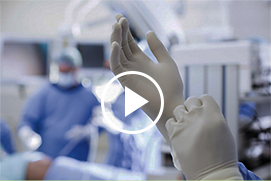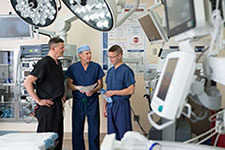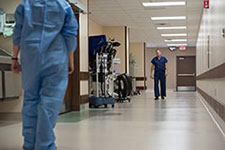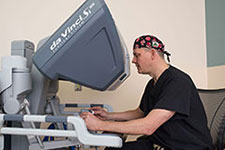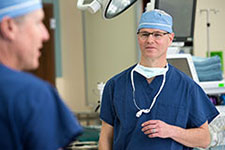Laparoscopy is a procedure used to check the organs in the belly (abdomen). It can also check a woman’s pelvic organs.
Laparoscopy uses a thin lighted tube that has a video camera. The tube is called a laparoscope. It is put into a tiny cut or incision in your belly. The video camera images can be seen on a computer screen.
The benefit of laparoscopy is that it is minimally invasive. That means it uses a very small cut in the belly.
Laparoscopy may be used to take a small tissue sample for testing (a biopsy). It can also be used to remove organs such as the appendix (appendectomy) or the gallbladder (cholecystectomy).
Why might I need a laparoscopy?
An abdominal laparoscopy can be done to check the abdomen and its organs for:
- Tumors and other growths
- Injuries
- Bleeding inside the belly
- Infections
- Belly pain that can’t be explained
- Blockages
- Other conditions
A laparoscopy is often done when the results of a physical exam, X-ray, or CT scan are not clear.
Laparoscopy may be used to determine a stage of cancer for an abdominal organ. It may also be used to check an abdominal injury. It can see where the injury is and how deep it is. It can also see how much internal bleeding you have.
For women, a gynecologic laparoscopy may be used to check:
- Pelvic pain and problems
- Ovarian cysts
- Fibroids
- The fallopian tubes
Laparoscopy can also be used to treat endometriosis. This is when tissue that normally lines the uterus grows outside it. And laparoscopy may be done to remove an ectopic pregnancy from a fallopian tube.
There may be other reasons for your provider to suggest a laparoscopy.
What are the risks of a laparoscopy?
Possible complications may include bleeding from the incision or not placing carbon dioxide gas in the right area.
Sometimes a laparoscopy is not advised. This may be the case if you:
- Have advanced cancerous growths on your abdominal wall
- Have long-term (chronic) tubercul osis
- Have a bleeding problem such as low blood platelet count (thrombocytopenia)
- Have a lot of scar tissue (adhesions) from other surgeries
- Are taking blood-thinning medicine
There may be other risks depending on your medical condition. Be sure to talk about any concerns with your provider before the procedure.
Certain conditions may stop a laparoscopy from working well. These include being obese or having bleeding inside your abdomen.
How do I get ready for a laparoscopy?
- Your healthcare provider will explain the procedure to you. Ask him or her any questions you have.
- You may be asked to sign a consent form that gives permission for the procedure. Read the form carefully and ask questions if anything is not clear.
- Your provider will ask questions about your past health. He or she may also give you a physical exam. This is to make sure you are in good health before the procedure. You may also need blood tests and other diagnostic tests.
- You must not eat or drink for 8 hours before the procedure. This often means no food or drink after midnight.
- Tell your provider if you are sensitive to or allergic to any medicines, latex, tape, and anesthesia medicines (local and general).
- Tell your provider about all the medicines you take. This includes both over-the-counter and prescription medicines. It also includes vitamins, herbs, and other supplements.
- Tell your provider if you have a history of bleeding disorders. Let your provider know if you are taking any blood-thinning medicines, aspirin, ibuprofen, or other medicines that affect blood clotting. You may need to stop taking these medicines before the procedure.
- Tell your provider if you are pregnant or think you may be pregnant.
- You may have a solution put into your rectum and lower intestine (a cleansing enema) a few hours before the procedure.
- You may be given a medicine to relax you (a sedative) before the procedure. This depends on the type of laparoscopy being done. If this is an outpatient procedure, someone must drive you home.
Your healthcare provider may have other instructions for you based on your medical condition.
What happens during a laparoscopy?
A laparoscopy may be done on an outpatient basis or as part of your stay in a hospital. The way the test is done may vary. It will depend on your condition and your healthcare provider's practices.
A laparoscopy is generally done while you are asleep under general anesthesia. Your provider will choose the type of anesthesia based on the procedure and your overall health.
Generally, a laparoscopy follows this process:
- You will be asked to take off any jewelry or other objects that may interfere with the procedure.
- You will be asked to remove clothing and be given a gown to wear.
- An IV (intravenous) line will be inserted in your arm or hand.
- A tube (urinary catheter) may be placed in your bladder to collect urine.
- You will be placed on your back on the operating table.
- The anesthesiologist will check your heart rate, blood pressure, breathing, and blood oxygen level during the surgery.
- If there is too much hair at the surgical site, it may be clipped off.
- The skin over the surgical site will be cleaned with a sterile (antiseptic) solution.
- If general anesthesia is not used, a local anesthetic may be shot (injected) into the incision site. This will numb the area. You will feel a needle stick and a brief sting.
- A small cut or incision will be made in your belly just below the belly button.
- More small cuts may be made so that other surgical tools can be used during the procedure.
- Carbon dioxide gas will be put into your belly so that it swells up. This makes it easier to see organs and other structures.
- If general anesthesia is not used, you may feel some mild pain in your belly and the top of your shoulder. This may happen as the carbon dioxide is injected and surgical tools are moved around.
- The laparoscope will be put in and the exam will take place.
- Once the exam and any other procedures are done, the laparoscope will be taken out.
- The cut will be closed with stitches, tape, or surgical staples.
- A sterile bandage or dressing or adhesive strips will be applied.
What happens after a laparoscopy?
After surgery, you will be taken to the recovery room. Your recovery process will vary depending on the type of anesthesia you had. You will be watched closely. Once your blood pressure, pulse, and breathing are stable and you are alert, you will be taken to your hospital room. Or you may be sent home if this was an outpatient procedure.
When you are home, you must keep the cut clean and dry. Your doctor will give you instructions on how to bathe. Any stitches or surgical staples will be taken out at a follow-up office visit. If adhesive strips were used, they should be kept dry. They will often fall off in a few days.
You may feel pain from the carbon dioxide gas still in your belly. This pain may last for a few days. It should feel a bit better each day. You may take a pain medicine as directed by your provider. Aspirin or other pain medicines may raise your risk of bleeding. Only take medicines that your provider has approved.
Don’t have any carbonated drinks for 1 or 2 days after the procedure. This will help reduce the mild pain from the carbon dioxide gas. Also, carbonated drinks may upset your stomach.
You may be allowed to drink clear fluids a few hours after the procedure. You may slowly move on to more solid foods as directed.
You may be told to limit your physical activity for a few days.
Call your healthcare provider if you have any of the following:
- Fever or chills
- Redness, swelling, or bleeding or other drainage from the incision site
- More pain around the incision site
- Vomiting
- Trouble urinating
Your healthcare provider may give you other instructions, depending on your situation.
Next steps
Before you agree to the test or the procedure make sure you know:
- The name of the test or procedure
- The reason you are having the test or procedure
- The risks and benefits of the test or procedure
- When and where you are to have the test or procedure and who will do it
- When and how will you get the results
- How much will you have to pay for the test or procedure



